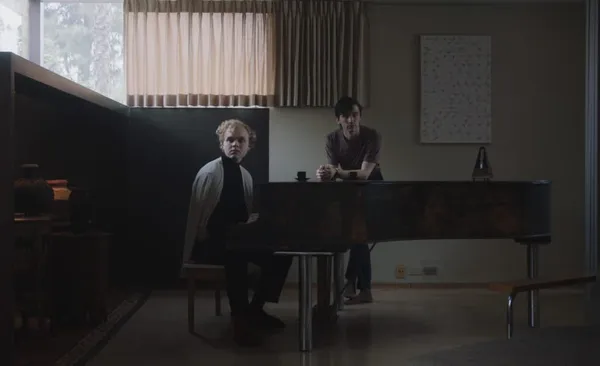Eye For Film >> Movies >> The Bloodhound (2020) Film Review
The Bloodhound
Reviewed by: Jennie Kermode

In 2021, the toll that isolation can take on mental health is understood better than ever before. it's particularly tough for those who have a tendency towards mental illness to begin with. Edgar Allan Poe's Fall Of The House Of Usher was one of the first works to explore the conjunction of these two factors from a modern perspective. It has been interpreted for the cinema several times, but Patrick Picard's stripped-down, 21st Century version is perfectly suited to the pandemic era.
Whilst the frame of the story remains, the names have been changed. We follow Francis (Liam Aiken) as he goes to visit his reclusive friend Jean Paul (Joe Adler) in the latter's remote home. Jean Paul's twin sister Vivian (Annalise Basso) is also present in the house but rarely glimpsed. Picard finds the crux of the story in the relationship between the two men. This brings the queer subtext of the story into the open, though Francis studiously avoids acknowledging it. It also intensifies the sense that Jean Paul's account cannot be trusted, and likewise the air of uncertainty about Vivian's supposed ill health.
For those new to the tale, it should be noted that Jean Paul believes his sister is suffering from a form of hereditary madness which he too may fall prey to. This is bound up somehow with his family's relationship with the house (not as fantastical as it might sound, thanks to the effects of certain moulds, though that is not addressed here). He describes a dream in which some barely human thing which he refers to as the bloodhound is coming for him through the sewers, a neat way of updating the original's Gothic preoccupation with paranoia, decay and the subterranean. A scene in which Francis is trapped in the vault where wine is kept recalls another Poe tale, The Cask Of Amontillado, with the space evincing no less danger for its smoothly plastered walls, neat grey carpet and modern locks. Later it will become the focus of Vivian's - or possibly Jean Paul's - fixation on the horror of being buried alive.
Restricted to these plain, civilised spaces and shorn of the Gothic trappings of the original, The Bloodhound also uses a deliberately flattened affect, with a heavily stylised approach to dialogue holding for most of its running time. A ghost of homophobic panic keeps Francis from making eye contact with his host, further increasing the distance between them. Where previous versions have been inflamed with passion, this is icy cold, showcasing a different, more commonplace and obviously miserable form of mental illness. Jean Paul's isolation is much more than just physical, and as he desperately reaches out to Francis for help, we are constantly aware of the danger that Francis will be drawn in. The house is still and quiet as a tomb, its layers of plaster and steel and slick glass sealing them in. We can see a little of what lies beyond, but never touch it.
With its realism comes the film's chief problem: it. too, is difficult to get close to, and without an investment like Francis' it's not clear why one would want to. If you have a passion for Poe, however, that may be enough to persuade you to visit this old friend. What you will find is somewhat bloodless, just the bones remaining, but it still has the power to haunt.
Reviewed on: 14 Jan 2021

















